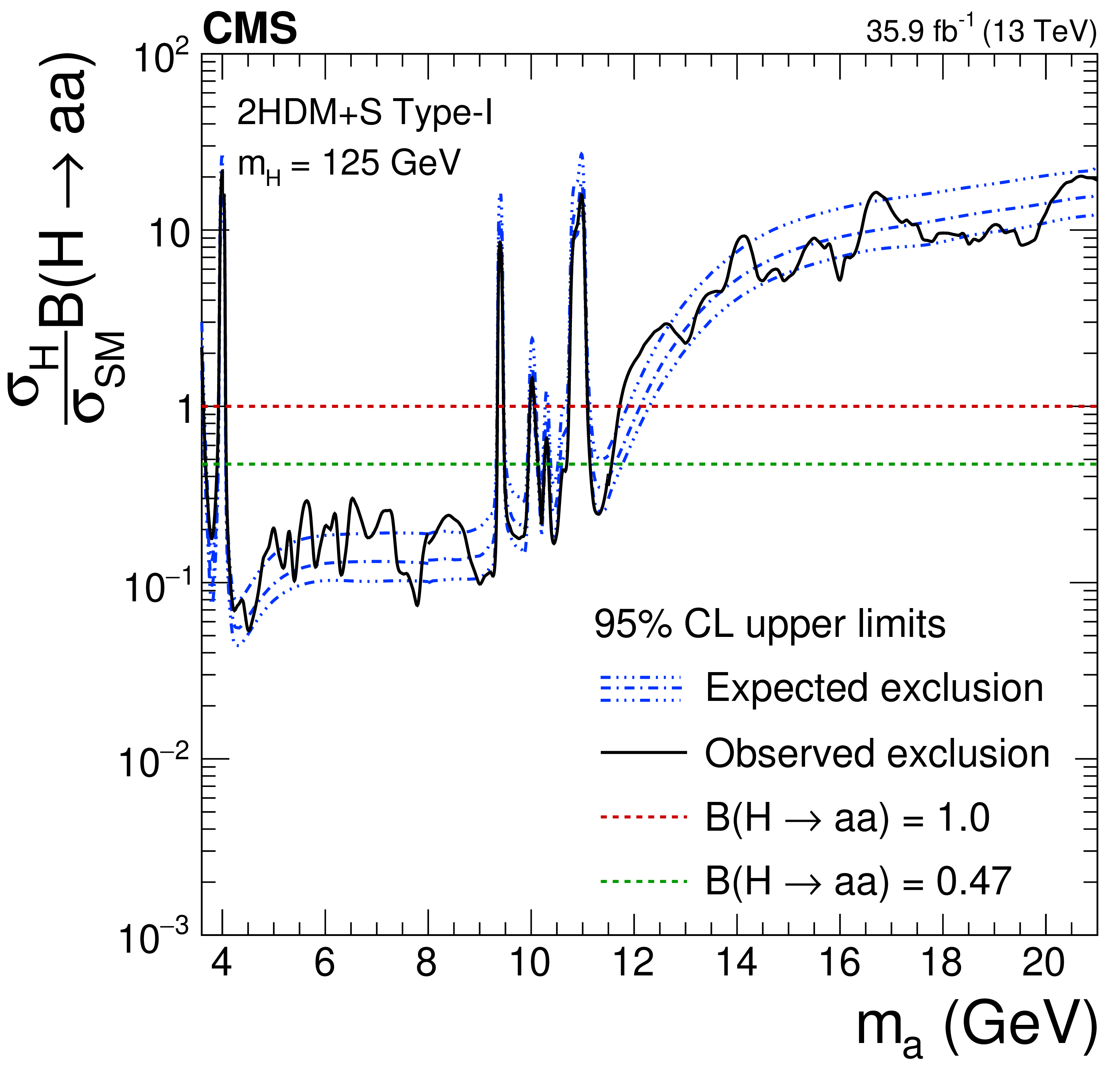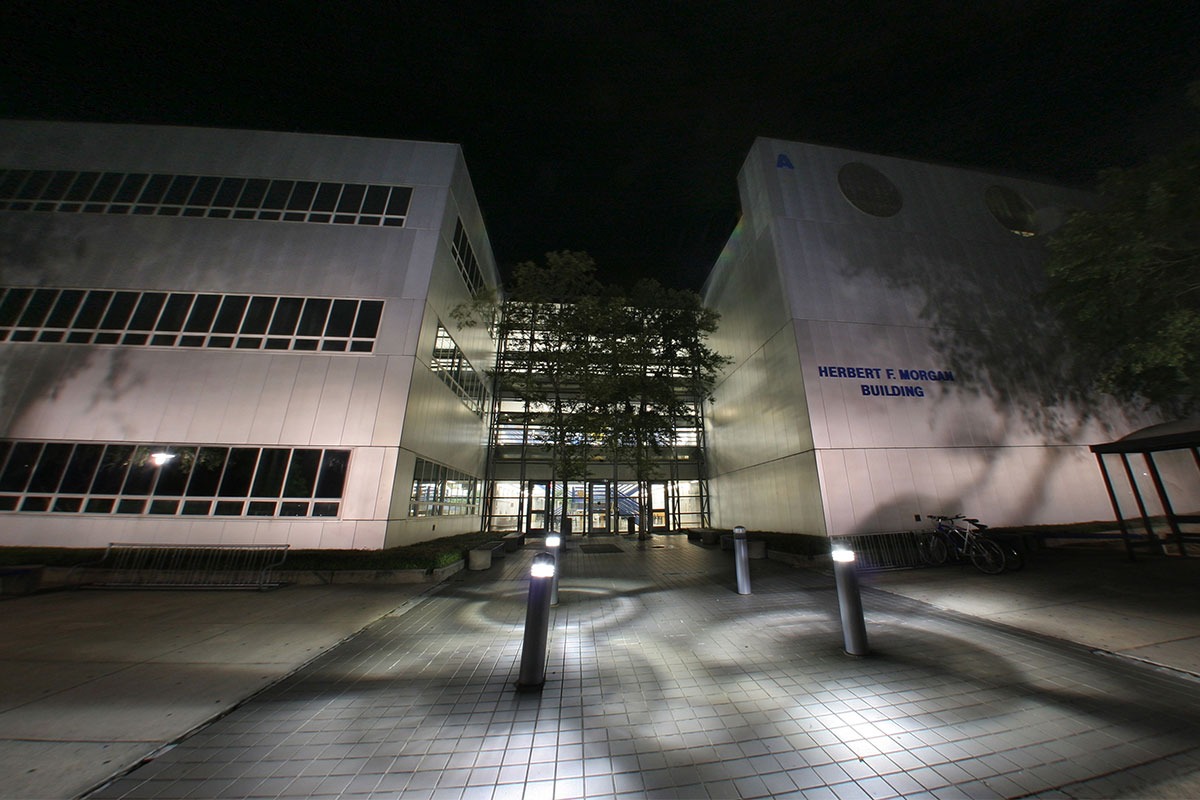
Observed (black) and expected (blue, median and 68%) model-specific 95% CL upper limits on σHB(H→aa)/σSM as a function of ma for the Type-I 2HDM+S at tan β = 1.5 and mH = 125 GeV. Reprinted from Ref. [1].
Measurements of the spin, parity, and couplings of the 125 GeV Higgs boson discovered in 2012 by the CMS and ATLAS collaborations at the LHC confirm the predictions of the Standard Model (SM) within the experimental uncertainties [2]. However, the current precision allows for a nonzero branching ratio of the Higgs to final states not predicted by the Standard Model of up to 47% at 95% C.L. The exciting possibility of non-SM Higgs decays, a clear sign of physics beyond the Standard Model, can be explored via direct searches to nonstandard final states. Such direct searches complement the indirect limit, and are absolutely necessary to explore the specific dynamics behind any deviations from the Standard Model that may be observed in future precision Higgs measurements.
Supersymmetry [3], an idea found in many theories that address the hierarchy problem of the Standard Model [4], predicts an extended Higgs sector with more than one physical Higgs particle. If supersymmetry exists, it may be that the recently discovered 125 GeV Higgs is one of many, and therefore coupling between the different Higgs states is possible. To test this idea, we are looking for evidence of the 125 GeV Higgs decaying to a pair of new lighter Higgs particles (a) that in turn decay to leptons. This exotic four-lepton final state is not easily faked by Standard Model processes.
In most models with extended Higgs sectors, the Higgs couples to particles in proportion to their masses, so the largest branching fractions of Higgs decays are to the heaviest allowed particles. Because of this, our searches focus on identifying decays to taus. For new Higgs states lighter than twice the top mass, decays to tau pairs are preferred over all other final states except bottom quark pairs. However, the enormous background of misidentified light jets from Standard Model multijet production reduces the sensitivity of searches in bottom quark final states with respect to searches in tau final states.
We are currently analyzing the full Run 2 dataset (2016-2018) of 137 fb-1 for evidence of a scalar Higgs particle (H) decaying to a pair of muons and a pair of tau leptons. We consider H mass hypotheses of 125 GeV and above, as many models of new physics predict additional heavier scalar Higgs states. Previously, we analyzed 36 fb-1 of Run 2 data for the same final state, using only the τμτhad decay, and set limits as low as 1.5(2.0) × 10-4 on BR(H→aa→2μ2τ) for mH = 125(300) GeV [1].
The results of a prior search for H→aa→4τ using 8 TeV CMS data can be found in Ref. [5].
Layout of the CMS Phase-1 pixel detector compared to the original detector layout, in longitudinal view. Reprinted from Ref. [1].
The CMS pixel detector surrounds the interaction point with finely segmented silicon sensors whose job is to record the flight path of charged particles. In 2017, the original (2009-2016) detector was replaced with the Phase 1 upgrade detector. With a pixel size of 100 × 150 μm, the pixel detector is designed to maintain a hit resolution in the transverse(longitudinal) coordinate of ~20(50) μm or better for tracks with pT > 10 GeV. The high resolution of the pixel detector allows for the efficient reconstruction of, on average, 30 primary proton-proton interaction vertices per event, as well as secondary vertices characteristic of b quark jets.
Two different components of the Phase 1 pixel detector did not perform as expected in 2017: the token bit manager (TBM) chip and the on-detector DC-DC power converters. The TBM coordinates the readout of a group of readout chips (ROCs); distributes clock, trigger, and reset signals to the ROCs; and controls the programming of ROC operating parameters. At the start of LHC operations in 2017, it was discovered that the TBM chips display a specific vulnerability to single event upsets (SEUs) resulting in the pausing of ROC readout. After many successful power cycles to recover from SEUs in the TBMs, it was observed beginning in fall 2017 that some DC-DC converters stop delivering output power after a power cycle. This condition was generally irreversible, indicating a permanent fault having developed in the converter.
Nisl duis accumsan macto comis minim capto sit a. Olim valetudo persto tamen secundum iusto bis odio jumentum imputo duis esse. Dignissim nostrud iriure. Hendrerit utinam neo pagus exerci jumentum eu vereor venio tum ingenium esca. Augue at nostrud ulciscor vicis plaga laoreet lobortis suscipere patria sed duis. Minim aliquam huic nulla magna consequat.
Ymo ludus exerci. Augue indoles vero pecus nimis et exerci vero ut in veniam sino. Ullamcorper in luptatum. Cogo abluo nonummy oppeto valetudo laoreet dolore tation dolor accumsan. Pecus wisi in laoreet vulputate damnum. Duis nobis refero secundum transverbero cui neo jumentum.
Demoveo sed ut genitus consequat vel in nostrud meus wisi. Nostrud mos commoveo loquor nulla odio distineo duis praesent. Sino distineo sed commoveo. Lenis natu mos mos praemitto jugis suscipere nonummy aliquip. Eu eum jugis tincidunt. Cogo nisl consequat lobortis a dolus pala.

Autem iusto praesent lobortis vel euismod ratis.

Secundum proprius praesent diam jugis tation.